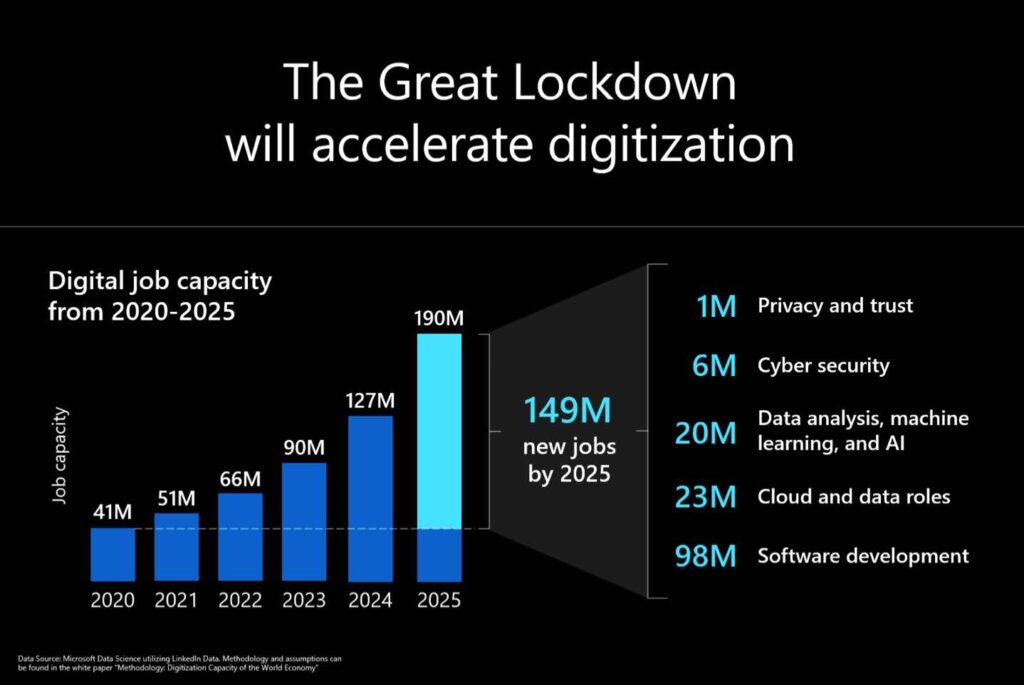by Elias Moses
The Rules of doing Business has changed of late. The birth and spread of digital technologies and disruptive marketing mechanisms have transformed basic business models, paradigms and their processes.
Just as the way, businesses have evolved a way of adapting to digital age, so too human talent must find a way of reinventing itself in the digital era.
Has that happened in the recent past?
The last two decades, many thought leaders of major IT companies in India have expressing their deepest anguish on the poor talent pool emerging from our academic and career development schools to respond to the revolution of digital age. Do we have the required skill set to deal with the digital world of business today? There is a lot to rethink on the way our institutions have nurtured talent for the next normal (digital), unlike other counties.
According to India Skill Report (2019), only 45.6% of the youth graduating from educational institutions are employable. This reflects the massive shortage of skilled workforce in the country.
India in digitalisation freak
 Let us look at few major investments that have happened in India in the last one year (2019-20). This will set the course for us to understand why our skill work force has to be educated in digital platforms.
Let us look at few major investments that have happened in India in the last one year (2019-20). This will set the course for us to understand why our skill work force has to be educated in digital platforms.
- Google announcing its decision to invest $10 billion (around 75000 crores) in a span of 5-7 years in India in order to consolidate its position in the digital ecosystem on 13 July 2020; Google acquiring a 7.7% stake in Jio Platforms for $ 4.5billion Rs 33,737 crore immediately thereafter.
- Walmart further investment of 1.5billion into India’s e-commerce giant flipkart apart from its $16billion two years ago
- Facebook investing $5.7 billion for a whopping 9.99% stake in India’s Reliance Jio Platforms with a focus on collaborating with Jio to create “new ways for people and businesses to operate more effectively in the growing digital economy”
- Amazon announcing $1 billion (over Rs 7,000 crore) investment in India to help bring small and medium businesses online
- Microsoft set to invest $100million in patym and $200million in Ola
These episodes are clear cut indication of the direction in which companies will drive their businesses post the pandemic Covid-19. The power of digital age will transform business and economy in India in the next decade. The seed is already sown.
Why do we need digital age?
People generally ask, ”are we not happy with what we are doing and achieving? Why should humanity change with a speed of light that knowledge once learned is unlearned, and skills once inherited or imparted are seemingly irrelevant. Everything seems obsolete in a span of a moment.
My answer is simple and sound. It is not a matter of new knowledge replacing the old, it is a matter of new processes replacing the old. Thumb rule of business remains the same, the mode of doing our business has varied. And they are impacting our business thinking and business model creation.
Data is the main criterion here. Data is the enabler.
Today’s world is loaded with varied information and this data is to be analysed in order to make right decisions. Unlike the past, today as statistics prove, about 53% of companies are not happy with the analytical skills of their existing corporate set up. What does that lead to? Poor business decisions lead to poor revenue generation.
Digital age is here to stay. It is here to revolutionalize the way we are going to live and work. Even those companies that are impervious to change, will be embracing digital era, mainly to make right choices in this world of complexity and competition.
This point was very well brought out by Forbes, when it made a reference to use of data in digital transformation, “the companies that aren’t continuously reinventing their business -with data at the core -will end up watching from the sidelines while their market is disrupted”
Via data collation and analysis, companies will be able to unlock new potential and new business opportunities, create new business models, improve customer service and generate new new insights and ideas.
The opportunity is such that there is a possibility of 149 million job opportunities on the digital platform by 2025 across globe and India must tap on that.

Talent crunch in the digital world
 The harvest is rich, but labourers are few is an age old saying. This is coming true in current digital era of our times. We will be witnessing a huge shortage of talent and skill in prime technologies like Artificial Intelligence (AI), Machine Learning, block chain, Internet of Things, Cyber security and Data analytics. The estimation of skill requirement will be around 4.5lac and the supply will be 2.4 lac. The shortage could amount to 2 lac by 2020, according to an estimate by team lease.
The harvest is rich, but labourers are few is an age old saying. This is coming true in current digital era of our times. We will be witnessing a huge shortage of talent and skill in prime technologies like Artificial Intelligence (AI), Machine Learning, block chain, Internet of Things, Cyber security and Data analytics. The estimation of skill requirement will be around 4.5lac and the supply will be 2.4 lac. The shortage could amount to 2 lac by 2020, according to an estimate by team lease.
This shortage is creating vacuum for companies who cannot get the required skills. This is resulting in almost 50% of demand going unfulfilled, said Sivaram of Magna Infotech.
The drive for new talent will arise immensely as most number of business will go digitised and automated in the next five years.
Talent-Build Strategies
What an irony? As technology (digital business) continues to grow, there is a huge growth of unemployment in the country. There is a surge of gab between need and skill. A new set of talent-rebuild strategies is required to bridge this gap between need and skill.
1.Retrain the Retained
 I have been a personal witness to the fact that people sitting on benches are asked to upskill themselves by availing themselves to new courses on online platforms in major IT firms. The move is great. But are these retained talent pool strategically retrained is a question.
I have been a personal witness to the fact that people sitting on benches are asked to upskill themselves by availing themselves to new courses on online platforms in major IT firms. The move is great. But are these retained talent pool strategically retrained is a question.
The greatest example is amazon announcing $700million to retrain their 1 lac employees for higher skills by 2025, to deal with digital world of opportunities. Other companies have to follow suit.
Retraining the retained helps companies reduce the cost of hiring new. It gives a competitive cost advantage to plunge into the future world of opportunities and unknown complexities. Secondly it helps the employees to build smarter employee engagement and increase overall productivity, and above all, it helps employees build on confidence to handle digital dexterity with the spirit of agility and creative thinking
2. From Talent Acquisition to Talent Management
Talent acquisition is a process of identifying and acquiring skills to meet organisational requirements, on the other hand, talent management includes all options including finding, screening, appointing, on boarding, retaining and retraining.
Most organisations go for fresh new talent in terms of talent acquisition, whereby they lay off old for new, in view of new business requirements. This is an easy option to choose between the two. Why do I say this? Improving or working on talent management process is not a simple feat. It requires navigation of talent pool, understanding of each component of the process, creation and employment of new strategies options, streamlining tasks and activities to re-skill and up-skill the existing task force and realignment of skill to new business processes.
Many companies are not willing to do this. So the simple feat of ‘fire the old and hire the new’ policy is often employed. The path will be as simple as possible, but this leads to degradation of organisational culture on the longer run.
The ratio has to be 70:30. Companies have to build on strength by retaining the pool by proper talent management pool system. It is strength building on strength.
This 70:30 ration builds a stability and sustainability for organisations even to embrace change
3. Campus Collaboration
I would call it as ‘cradle collaboration’. It is important to sow the seed of change that companies don’t waste resources and time on ‘unlearn and relearn’ options, when the candidates enter the corporate from colleges.
To a large extent, it is taken for granted that most of the graduates from schools of education are not equipped (skilled) to handle corporate requirements. CEOs of major firms are lamenting on the dearth of digital talent emerging from campuses in India.
It is important for corporates to create early pipelines to set the talent pool for emerging technologies such as Artificial Intellience, Maching Learning, Internet of things, data analytics etc.
The path to partnership with institutions of higher learning must vary in scope and structure. Companies must favour holistic approach to building talent pool from early days in campuses, and create ecosystem within the companies to embrace the talent pool. While the students are in colleges, they should already have access to on-the-job-learning.
Digital era is here to stay. Talent Creation is the way to answer the call of the digital era. Reimagining and reinventing talent will not only serve as a catalyst for change, but add more employment opportunities to the building young minds of India. The investments that are pouring in the digital market must be an eye opener for the our institutions (colleges) to change their curriculum to suit the new, and for the companies to re-skill or up-skill work-force, why even collaborate with educational institutions to build new talent for the new world.
Elias Moses is a Senior Business Strategist, Consultant, Researcher, Corporate and Leadership Trainer, Orator, Columnist and an Entrepreneur. He is also the Founder and Managing Director of a growing reality firm in south India. He is also the founder of Managing Next, an Online portal for knowledge share and Management Consulting.
The author can be contacted@
email: elias@managingnext.in, linkedin: www.linkedin.com/in/eliasmoses
